 Texture Panel
Texture Panel
The menu item to show and hide the Texture panel can be found in the main menu under Window > Astute Graphics > Texture.

Texture Panel Overview
1. Flyout menu
See Texture Panel: Flyout Menu.
2. Panel banner
The help button on the right opens the help documentation in the Astute Manager. If this does not automatically appear, please ensure your Astute Manager is running first.
Click on the other area of the color bar to activate the Texture tool. This is a quick method of locating the tool within the default Advanced toolbar or a custom toolbar.
3. Add Button
Adds the texture being previewed on the panel to the selected artwork and (if necessary) switches the current tool to the Texture tool to allow immediate editing of the texture’s parameters, such as position, scaling, and so on, using the on-screen tool annotations (see Texture: Tool Operation).
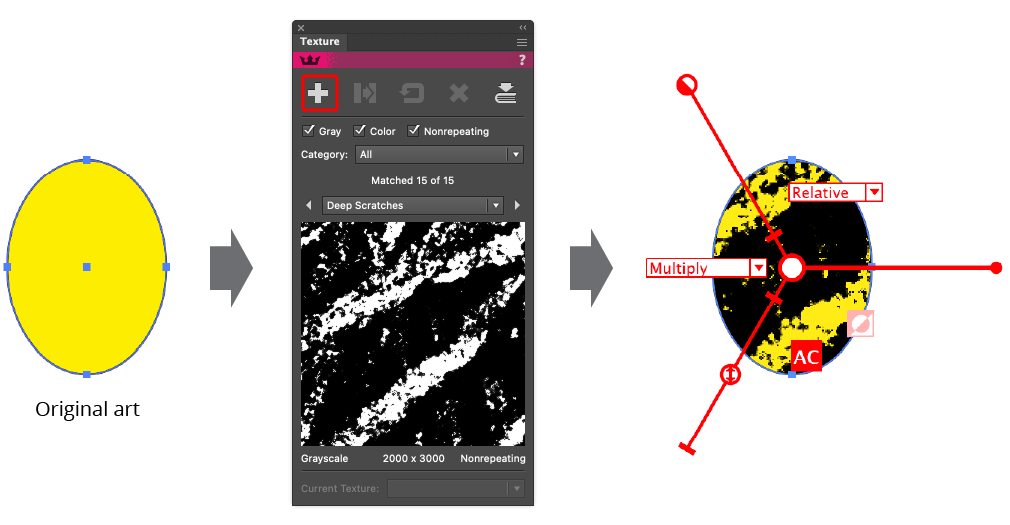
Texture Panel Add Button
Normally, when a new texture is added, its parameters are reset to their defaults, but if the Option/Alt key is held down when clicking the Add button, the parameters will be retained from the last texture that was selected or edited. Multiple copies of the same texture may be added.
4. Replace Button
Replaces the current texture (as indicated by the Current Texture menu at the bottom of the panel) with the texture being previewed on the panel, retaining all parameters.
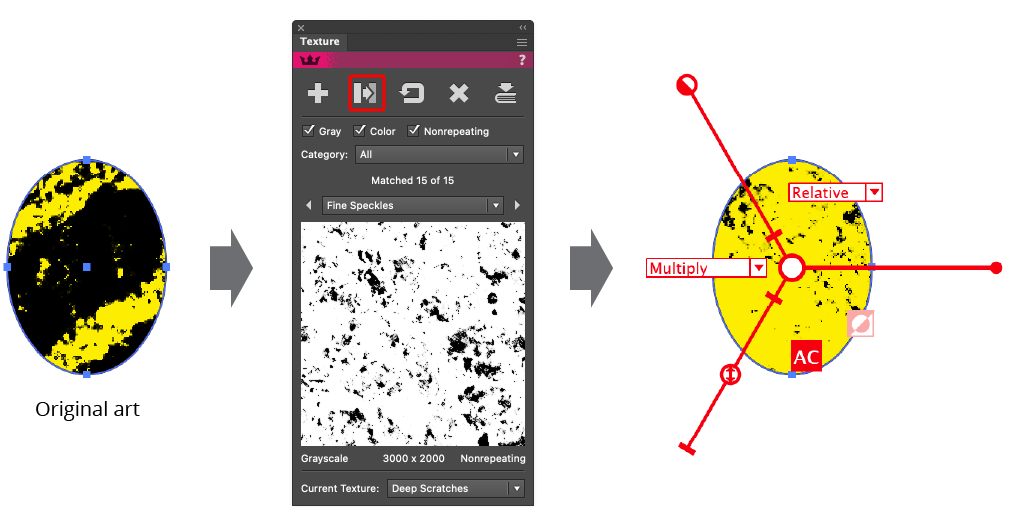
Texture Panel Replace Button
5. Reset Button
Resets the current texture’s parameters to their defaults: relative positioning with no offset; scaling 100%; rotation 0°; opacity 100%; Invert disabled; Auto Cover enabled; and blending mode equal to the texture’s “Initial Blend Mode” (set for each texture in the Texture Manager, with a default of Multiply).
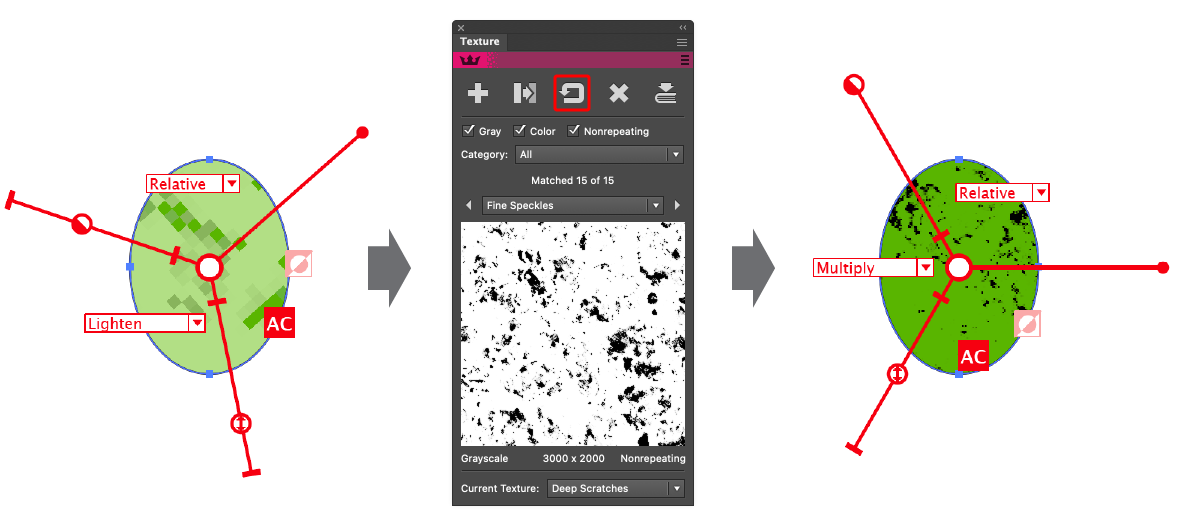
Texture Panel Reset Button
If the Option/Alt key is held down when clicking the Reset button, then all the textures in the targeted art object will be reset.
6. Remove Button
Removes the current texture (as indicated by the Current Texture menu at the bottom of the panel) from the targeted art object. If the Option/Alt key is held down when clicking the Reset button, then all the textures in the targeted art object will be removed.
7. Import Button
Allows one or more new textures to be created and added to the library from one or more existing PNG, TIFF, or JPG files, using the standard file open dialog. A warning will be shown if a texture being imported conflicts with an existing texture. After the import process has completed, a dialog will report the total number of textures that were successfully added to the library.
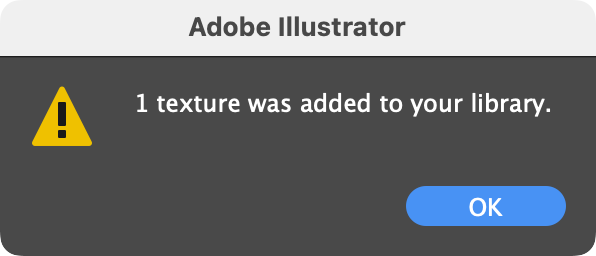
Texture Import Results Dialog
The Texture Manager will then automatically open with the newly-imported textures selected (see Texture: Texture Manager).
If the Option/Alt key is held down when clicking the Import button, the Texture Manager will be opened instead.
8. Filtering Parameters
These three checkboxes allow you to filter the textures in your library in order to make it easier to locate a desired texture. For example, if you are only interested in seeing color textures, deselecting the Gray checkbox will hide all grayscale textures from the Texture Selection menu. (Note that this only keeps matching textures from appearing in the panel’s selection menu; non-matching textures already added to artwork can still be replaced, reset, deleted, or edited using the Texture tool.) Nonrepeating textures are those which do not seamlessly repeat from left to right and top to bottom like a pattern.
9. Category Popup Menu
Choosing a category from the menu limits the textures shown in the Texture Selection menu to those textures that have that category assigned. A texture’s category can be changed using the Texture Manager (see Texture: Texture Manager). There are three special categories at the top of the menu: All, which shows textures of any category; Favorites, which shows only textures which have been favorited; and Recently Used, which shows up to five of the most recently-used textures.
10. Matching Status Line
Displays the number of textures which are currently being displayed in the Texture Selection menu (after being filtered by Gray/Color/Nonrepeating and Category), as well as the total number of textures in the library.
11. Texture Selection Area
Allows you to select a texture from the library so it may be added as a new texture to artwork or replace an existing texture. The previous and next buttons step through each texture one by one (wrapping around at the beginning and end); the popup menu allows to to select a texture directly by name, from among those textures which match the filtering checkboxes and Category menu.
12. Texture Preview Area
Displays a preview of the texture that is selected in the popup menu above it. By default, the texture is shown at actual size; if the texture is larger than the preview window, it will be cropped. To see parts of the texture outside the crop, simply place the cursor over the preview window (the cursor will change to a hand) and drag. When the cursor is over the preview window, two icons will appear near the bottom:
Texture Panel Preview Window Icons
A. Favorite Icon: Allows you to quickly change a texture’s favorite status by clicking on it (when the star is filled, the texture is a favorite).
B. Preview Size Icon: When clicked, switches the texture’s preview between actual size and fit-to-window. Each texture’s view type is retained independently.
13. Texture Properties
Displays the following properties for the selected texture: color mode, pixel size, and repeating status.
14. Current Texture Selection
Reports the “current” texture; that is, the one in the selected art object which is targeted by the tool that would be replaced or removed using the buttons at the top of the panel. The popup menu allows you to choose the current texture when the art object contains multiple textures.
Texture Panel Flyout Menu
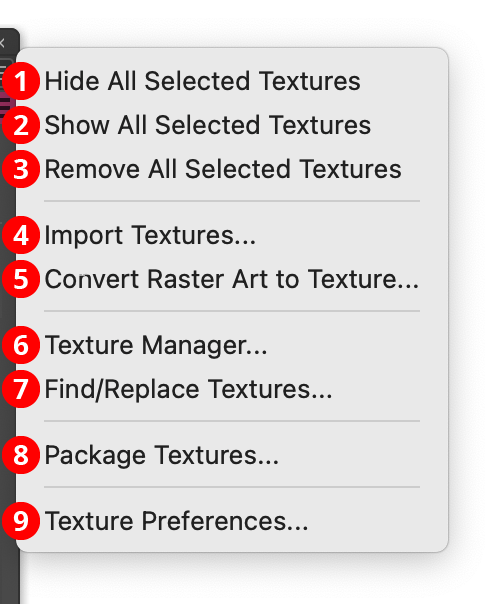
Texture Panel Flyout Menu
The Texture panel flyout menu items are contextually sensitive and all items may not be available, depending on the current selection.
1. Hide All Selected Textures
For all selected art with one or more non-hidden Texture live effects, causes their textures to be hidden, just as if their Visibility icon were clicked in the native Appearance panel.
2. Show All Selected Textures
For all selected art with one or more hidden Texture live effects, causes their textures to be shown, just as if their Visibility icon were clicked in the native Appearance panel.
3. Remove All Selected Textures
Removes all Texture live effects from all selected art objects.
4. Import Textures...
Imports new textures, as if the Import button on the panel were clicked (see Texture Panel: Import Button).
5. Convert Raster Art to Texture...
Available when one or more raster (embedded) art objects are selected, this function creates a new texture from each raster object, which remains unchanged. After conversion, the Texture Manager will automatically be opened with the newly-converted textures selected. They will have been given names like “Converted,” “Converted [1],” etc., but can be renamed.
6. Texture Manager...
Opens the Texture Manager (see Texture: Texture Manager).
7. Find/Replace Textures...
Opens the Find/Replace Textures dialog, used to locate textures, replace one texture with another, or replace textures which are missing or mismatched:
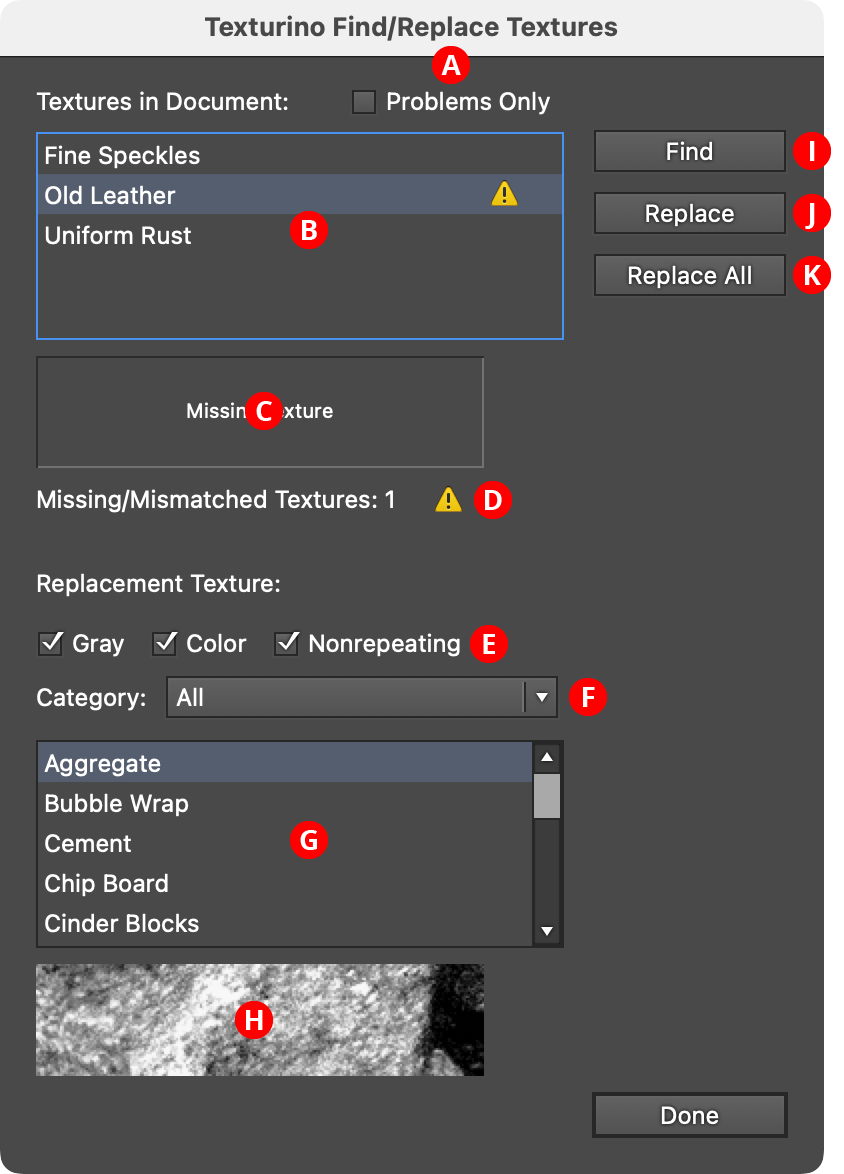
Find/Replace Textures Dialog
A. Problems Only Checkbox: When enabled, only those textures in the document which are missing (the texture cannot be located) or mismatched (a texture with the same name exists, but it is not the same texture that was originally added) are shown in the top list.
B. Textures in Document List: Lists either all the textures used in the current document, or, if Problems Only is enabled, the missing or misplaced textures in the current document. Problem textures display a warning symbol to the right of their name. When a texture is selected in the list, the document is automatically scrolled so that the first instance of the texture is centered within the document window.
C. Document Texture Preview Area: Previews the selected document texture, unless it is missing or misplaced. A clickable preview size icon will appear when hovering the cursor over the window.
D. Missing/Mismatched Status Line: Shows the number of problem textures in the current document, if any.
E. Filtering Parameters: Act the same as the filtering parameters checkboxes on the panel.
F. Category Popup Menu: Acts the same as the category popup menu on the panel.
G. Texture List: Lists textures that may be used for replacement (textures that match the filter parameters and category specified above).
H. Replacement Texture Preview Area: Previews the selected replacement texture. A clickable Preview Size icon will appear when hovering the cursor over the window.
I. Find Button: Each time the Find button is clicked, the artwork containing the next instance of the selected document texture is selected, and the document is scrolled so that artwork is centered within the document window.
J. Replace Button: Replaces the single instance of the texture that was originally selected or subsequently located using the Find button with the replacement texture, keeping all of its live effect parameters unchanged. Afterwards, the document is automatically scrolled to the next instance of the texture, if any.
K. Replace All Button: Replaces all instances of the selected texture in the document with the replacement texture, keeping all of their live effect parameters unchanged.
All texture replacements made while the Find/Replace Textures dialog is open can be undone in a single operation after the dialog is closed. If the Find/Replace Textures... menu item is unavailable, then there are no textures in the document.
8. Package Textures...
Brings up a dialog that allows you to export all of the textures used in the current document (except missing or mismatched textures) into a folder, the name and location of which can be specified. The textures are exported in PNG format. This is useful when giving the document to another user who also has the Texturino plugin installed and needs to edit the artwork that has Texture live effects. Before opening the document, that user should import all of the textures in the packaged folder so they will be present in their library.

Package Textures Dialog
8. Texture Preferences...
Brings up the Preferences dialog (see Texture: Preferences).
